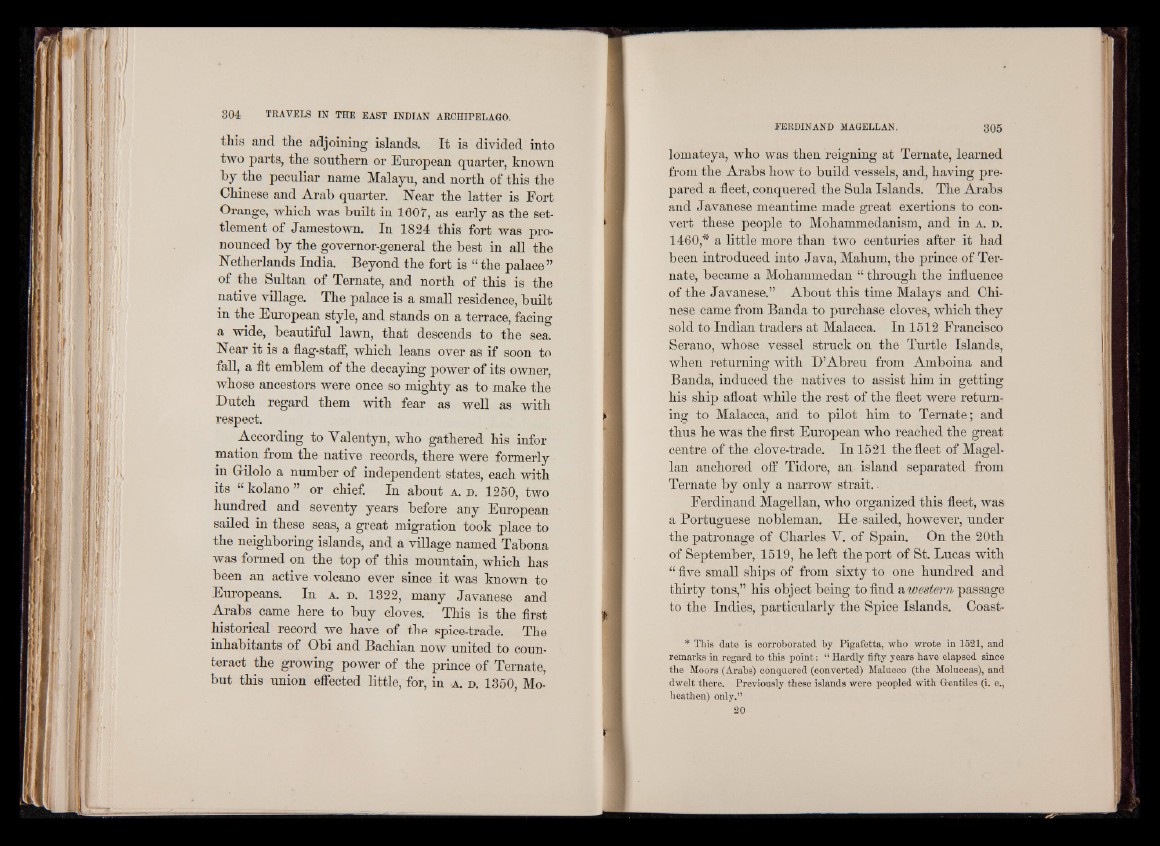
this and the adjoining islands. It is divided into
two parts, the southern or European quarter, known
by the peculiar name Malayu, and north of this the
Chinese and Arab quarter. Near the latter is Fort
Orange, which was built in 1607, as early as the settlement
of Jamestown. In 1824 this fort was pronounced
by the governor-general the best in all the
Netherlands India. Beyond the fort is “ the palace ”
of the Sultan of Temate, and north of this is the
native village. The palace is a small residence, built
in the European style, and stands on a terrace, facing
a wide, beautiful lawn, that descends to the sea.
Near it is a flag-staff, which leans over as if soon to
fall, a fit emblem of the decaying power of its owner,
whose ancestors were once so mighty as to make the
Dutch regard them with fear as well as with
respect.
According to Valentyn, who gathered his infor
mation from the native records, there were formerly
in Gilolo a number of independent states, each with
its “ kolano ” or chief. In about a . d . 1250, two
hundred and seventy years before any European
sailed in these seas, a great migration took place to
the neighboring islands, and a village named Tabona
was formed on the top of this mountain, which has
been an active volcano ever since it was known to
Europeans. In a . d . 1322, many Javanese and
Arabs came here to buy cloves. This is the first
historical record we have of the spice-trade. The
inhabitants of Obi and Bachian now united to counteract
the growing power of the prince of Ternate,
but this union effected little, for, in a . d . 1350, Molomateya,
who was then reigning at Ternate, learned
from the Arabs how to build vessels, and, having prepared
a fleet, conquered the Sula Islands. The Arabs
and Javanese meantime made great exertions to convert
these people to Mohammedanism, and in a . d .
1460,* a little more than two centuries after it had
been introduced into Java, Mahum, the prince of Ternate,
became a Mohammedan “ through the influence
of the Javanese.” About this time Malays and Chinese
came from Banda to purchase cloves, which they
sold to Indian traders at Malacca. In 1512 Francisco
Serano, whose vessel struck on the Turtle Islands,
when returning with D’Abreu from Amboina and
Banda, induced the natives to assist him in getting
his ship afloat while the rest of the fleet were returning
to Malacca, and to pilot him to Ternate; and
thus he was the first European who reached the great
centre of the clove-trade. In 1521 the fleet of Magellan
anchored off Tidore, an island separated from
Ternate by only a narrow strait.
Ferdinand Magellan, who organized this fleet, was
a Portuguese nobleman. He sailed, however, under
the patronage of Charles V. of Spain. On the 20th
of September, 1519, he left the port of St. Lucas with
“ five small ships of from sixty to one hundred and
thirty tons,” his object being to find a western passage
to the Indies, particularly the Spice Islands. Coast-
* This date is corroborated by Pigafetta, who wrote in 1521, and
remarks in regard to this point: “ Hardly fifty years have elapsed since
the Moors (Arabs) conquered (converted) Malucco (the Moluccas), and
dwelt there. Previously these islands were peopled with Gentiles (i. e.,
heathen) only.”
20